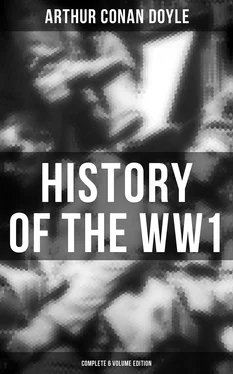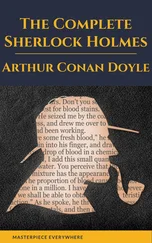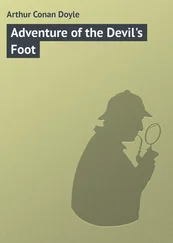Early on the morning of November 7 Lawford’s 22nd Brigade, which was now reduced to 1100 men, with 7 officers, was called upon to retake a line of trenches which the enemy had wrested from a neighbouring unit. Unbroken in nerve or spirit by their own terrific losses, they rushed forward, led by Lawford himself, a cudgel in his hand, carried the trench, captured three machine-guns, held the trench till evening, and then retired for a time from the line. Captains Vallentin and Alleyne, who led the two regiments into which the skeleton brigade had been divided, both fell in this feat of arms. After this action there remained standing the brigadier, 3 officers, and 700 men. The losses of the brigade work out at 97 per cent of the officers and 80 per cent of the men, figures which can seldom have been matched in the warfare of any age, and yet were little in excess of the other brigades, as is shown by the fact that the whole division on November 7 numbered 44 officers and 2336 men. It is true that many British regiments found themselves in this campaign with not one single officer or man left who had started from England, but these were usually the effects of months of campaigning. In the case of the Seventh Division, all these deadly losses had been sustained in less than three weeks. Britain’s soldiers have indeed been faithful to the death. Their record is the last word in endurance and military virtue.
The division was now finally withdrawn from the fighting line. It has already been stated that there were reasons which made its units exceptionally fine ones. In General Capper they possessed a leader of enormous energy and fire, whilst his three brigadiers—Watts, Lawford, and Ruggles-Brise—could not be surpassed by any in the Army. Yet with every advantage of officers and men there will always be wonder as well as admiration for what they accomplished. For three days, before the First Corps had come thoroughly into line, they held up the whole German advance, leaving the impression upon the enemy that they were faced by two army corps. Then for twelve more days they held the ground in the very storm-centre of the attack upon Ypres. When at last the survivors staggered from the line, they had made a name which will never die.
The bulk of Smith-Dorrien’s Corps had now been brought north, so that from this date (November 7) onwards the story of the First and Second Corps is intimately connected. When we last saw this corps it will be remembered that it had been withdrawn from the front, having lost some twelve thousand men in three weeks of La Bassée operations, and that the Indian Corps had taken over their line of trenches. Such fighting men could not, however, be spared in the midst of such a fight. The hospital was the only rest that any British soldier could be afforded. Whilst they had still strength to stand they must line up to the German flood or be content to see it thunder past them to the coast. They were brought north, save only Bowes’ 8th Brigade and Maude’s l4th, which remained with the Indians in the south. Although the Seventh Division had been drawn out of the line, its attendant cavalry division still remained to give its very efficient help to General Haig.
The British position, though by no means secure, was getting stronger day by day, for General d’Urbal of the Eighth French Army to the north, and General Maud’huy to the south, had both been strongly reinforced, and with their usual good comradeship did all they could to strengthen the flanks and shorten the front of the British line.
The men of the Second Corps who had come north from the La Bassée district were not left long unmolested in their new sphere of operations. On the afternoon of November 7 there was a hot German attack upon that portion of the line which had just been vacated by the Seventh Division. The trenches were now held by the Fifth Division (Morland’s).
The enemy may have hoped for some advantage from a change which they may well have observed, but they found that, though the units might be different, the same old breed still barred their path. On this occasion, after the early rush had spent itself upon the 1st Lincolns, it was the 2nd West Ridings who led the counter-charge. The line, however, was never fully re-established. A number of smaller attacks broke upon the front of the Second Division on the same day, leaving a few score of prisoners behind them as they ebbed. On the same day, November 7, the enemy got into the trenches of the 2nd Highland Light Infantry and remained in them, for all of them were bayoneted or taken. Upon this day the London Scottish were brought up into the Ypres line — a sign, if one were needed, that after the action described they were accepted as the peers of their comrades of the Regular Army, for no empty compliments are passed when the breaking of a unit may mean the enfilading of a line.
November 8 was a quiet day, but it was well known from every report of spy, scout, and aeroplane to be the lull before the storm. One German brigade came down the Menin road, and went up it again, leaving a hundred dead on or beside the causeway. This attack inflicted some loss upon the 1st North Lancashires and on the 1st Scots Guards. The 1st Bedfords captured a trench that night. The 9th and the 10th were uneventful, and the tired troops rested on their arms, though never free for an hour from the endless pelting of shells. To the north and east the Eagles were known to be gathering. There were the Emperor, the Emperor’s Guard, and a great fresh battle of the Germans ready for one grand final dash for Calais, with every rifle in the firing line and every cannon to support it. Grave messages came from headquarters, warning words were passed to anxious brigadiers, who took counsel with their colonels as to fire-fields and supports. Batteries were redistributed, depleted limbers refilled, and observation posts pushed to the front, while the untiring sappers gave the last touches to traverse and to trench. All was ready for the fray. So close were the lines that at many points the conversations of the enemy could be heard.
The Germans had already concentrated a large number of troops against this part of the British line, and they were now secretly reinforced by a division of the Prussian Guard. Documents found afterwards upon the dead show that the Guard had had special orders from the Emperor to break the line at all costs. The brigades which attacked were made up of the 1st and 2nd Foot Guards, the Kaiser Franz Grenadiers No. 2, the Königin Augusta Grenadiers No. 4, and the battalion of Garde Jäger—13,000 men in all. It was to be victory or death with the corps d’élite of the German army, but it was no less victory or death with the men who opposed them. After an artillery preparation of appalling intensity for three hours along the line of both the First and Second Divisions, the infantry advance began about 9:30 on the morning of November 11 amid a storm of wind and rain. They are gregarious fighters, the Germans, finding comfort and strength in the rush of serried ranks. Even now the advance was made in a close formation, but it was carried out with magnificent dash, amazing valour, and a pedantic precision which caused, for example, the leading officers to hold their swords at the carry. The Prussian Guardsmen seemed to have lost nothing, and also to have learned nothing, since their famous predecessors lay dead in their ranks before St. Privat, forty-four years before. The attack was directed against the front of the two divisions of the First British Army Corps, but especially on the 1st Brigade, so that Guardsman faced Guardsman, as at Fontenoy. There were none of the chivalrous greetings of 1745, however, and a stern hatred hardened the hearts of either side. The German Guard charged on the north of the Menin road, while a second advance by troops of the line was made upon the south, which withered away before the British fire. Nothing could stop the Guards, however. With trenches blazing and crackling upon their flank, for the advance was somewhat diagonal, they poured over the British position and penetrated it at three different points where the heavy shells had overwhelmed the trenches and buried the occupants, who, in some cases, were bayoneted as they struggled out from under the earth. It was a terrific moment. The yells of the stormers and the shrill whistles of their officers rose above the crash of the musketry-fire and roar of the guns. The British fought in their customary earnest silence, save for the short, sharp directions of their leaders. “They did not seem angry—only business-like,” said a hostile observer. The troops to the immediate north of the Menin road, who had been shelled out of their trenches by the bombardment, were forced back and brushed aside into the woods to the north, while the Germans poured through the gap. The 4th Royal Fusiliers of the 9th Brigade, upon the right of the point where the enemy had penetrated, were enfiladed and lost their gallant colonel, MacMahon, a soldier who had done great service from the day of Mons, and had just been appointed to a brigade. The regiment, which has worked as hard and endured as great losses as any in the campaign, was reduced to 2 officers and 100 men.
Читать дальше












